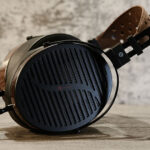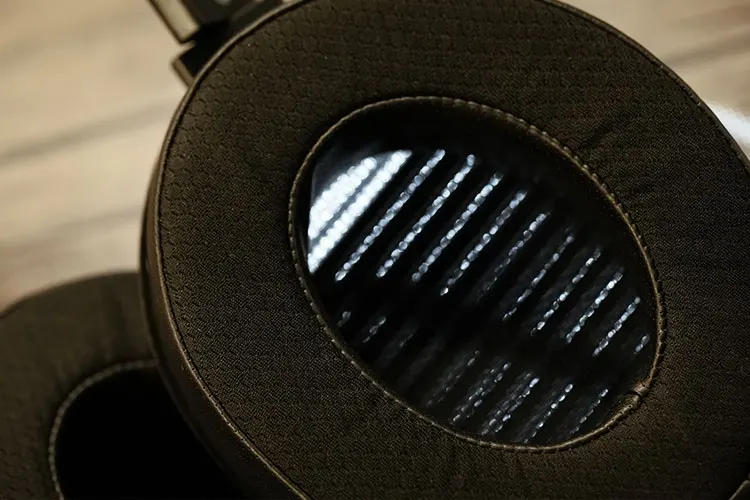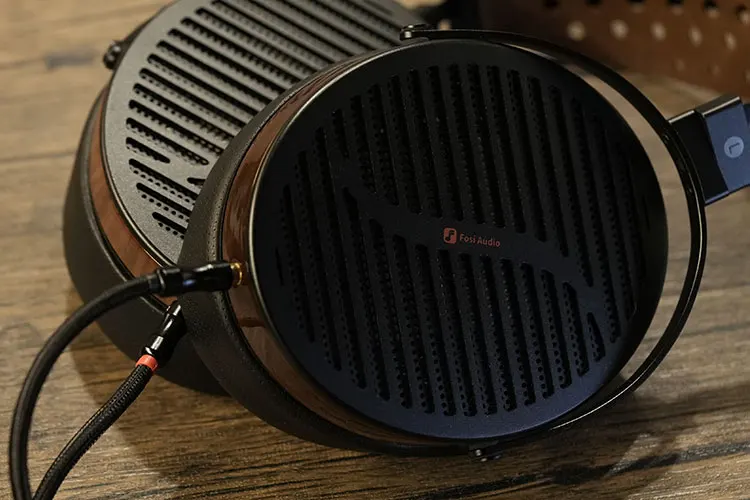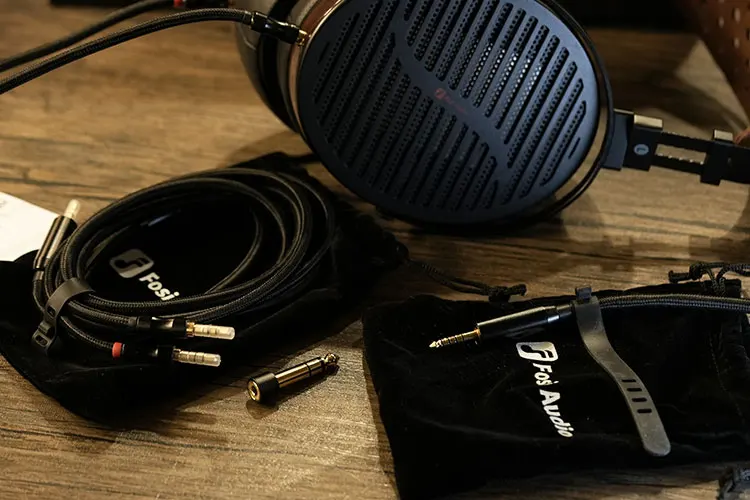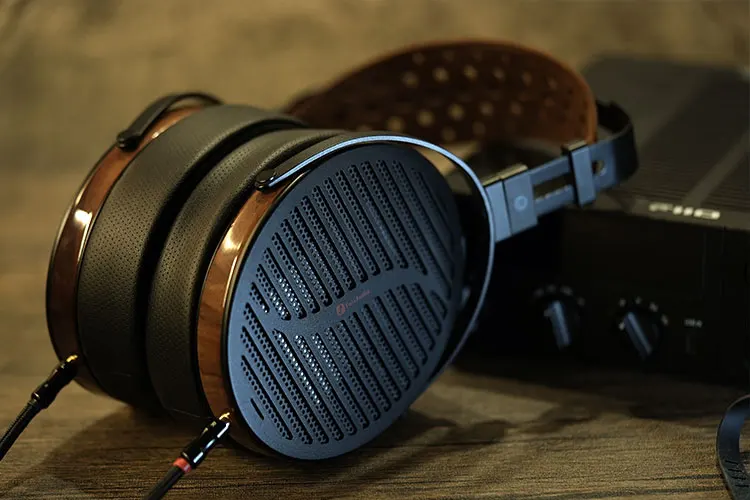In this feature, James reviews the Fosi Audio i5, a new set of open-back circumaural 97mm planar magnetic driver headphones with a current retail price of $549.99.
Disclaimer: This sample was sent to me for my honest opinion. Headfonics is an independent website with no affiliate links. I thank Fosi Audio for their support.
You can click here to learn more about Fosi Audio products previously reviewed on Headfonics.
This article follows our current scoring guidelines, which you can read here.
The open-back i5 Planar headphones are Fosi Audio’s first venture into the headphone market, equipped with a large driver and wrapped in a wooden chamber.
The i5 is currently available on Kickstarter for $387 or $439 with balanced cables included, and the SRP will be $549.99 afterwards.
The features and specifications look competitive, and it certainly is attractively built for the price. Its distinct M-shaped sound signature, combined with easy-to-drive properties, might make this a good choice for those who enjoy a tuning more to the warm and forgiving side.
In this review, I pitched the i5 against other popular planar headphones such as the MOONDROP Venus and the FiiO FT5 to find out if it is a solid entry in a growingly competitive mid-fi planar headphone market.
Features
The i5 comes with a 2μm-thick nano-level diaphragm that measures 97mm, a membrane size comparable to MOONDROP and FiiO planars I have tested.
Similar to other planar designs for boosting sensitivity, the i5 is equipped with a silver-etched voice coil that is just 1.3μm thick, flatly imprinted on its diaphragm, and coated with what they call a spluttered finish.
By using silver coils, the efficiency is enhanced compared to its copper counterparts and achieves 98 dB/mW for sensitivity. The i5 is rated at 28Ω in impedance, which suggests that there is some room to play with higher gain.
On each side of the membrane, there are 11 N50-grade neodymium magnets placed symmetrically to reduce nonlinear distortion. I have seen N52 implementations on other designs, but N50 should come quite close in magneticity.
The magnetic array totals 44 magnets, which is quite generous, and together with the driver membrane, they are mounted on a CNC inner housing that resides within the wooden frame. Therefore, I expect the timbre to be slightly colored by the wooden chamber as well.
Design
In the hand, the i5 feels very solid, possibly because of the lacquered Walnut wood middle frame that is not just a decoration but extends to the inner side to hold the drivers.
At 550g, the build feels premium with no plastic parts seen. Aluminum with a smooth finish is used intensively throughout the whole framework, giving good structural strength and likely helpful in suppressing unwanted resonance.
It is easy to notice that the i5 is designed to be opened with metallic meshes beneath the vented metallic cover. Together, the design looks minimalistic when viewed from the front, with the planar drivers barely visible through the meshes.
Comfort
The i5 has a stepless, friction-fit slider for headband adjustment, and once configured the first time, there is no need to reset it afterwards. Suede is used for the headband, and it is quite broad, which helps effectively spread the weight.
The movement of the earcups on its dual-axis framework is very smooth and without any noise, and helps it to tilt and self-adjust instantly once put on the head.
The overall comfort is satisfactory with moderately soft and thick padding. On another note, the oval-shaped earcups also fit better and have less leakage when having eyewear on compared to round designs.
Stock Cable
I received the version with a balanced 4.4mm cable and a single-ended 3.5mm version. There is also a more affordable option available that includes only the 3.5mm cable, which would be more suitable for pro audio users or pairing with vintage amplifiers.
The cables, made with 1120-strand 5N OFC silver-plated wire, feel very thick and rugged. They are nicely labeled with a heat shrink tube over the right side, indicated in red. While there is a bit of tangling, it is generally not messy and looks quite premium for a stock cable.
You can also use other cables with 3.5mm terminations, and there is an upgrade option available on the campaign page, with 48 strands of CVD Graphene Copper core that is said to be softer and more durable.
Packaging & Accessories
The sample unit I received has packaging that is quite minimalistic, with a thick cardboard box and foam padding to host the headphones and accessories.
The headphones are well-protected, and given the asking price, I shouldn’t expect anything less. However, it would be nice if a small fabric pouch or dust bag were included.
In addition to the cables and earphone units, the packaging also contains a 6.3mm converter, a small pouch for the cable, and a user manual.
Sound Impressions
After more than 100 hours of burn-in, which seems to tame to treble spike a little bit, I tested the i5 with powerful desktop gear, including the FiiO K17, K19, RME ADI 2-Pro, and the HIFIMAN EF500.
Please note that Fosi Audio has addressed a pre-production sub-bass issue in the i5 by adding a sound-isolating ring.
The improved version delivers noticeably fuller bass, and the updated frequency response is now consistent with expectations for planar magnetic headphones’ performance.
Summary
The character of the i5 is distinct. To me, it has an M-shaped profile with a rather sharp roll-off at both ends that doesn’t kill too much air.
It features warm, punchy bass and good energy in the upper vocal frequencies, allowing all voices to cut through the mix clearly with good vividness.
The subtle energy spike reveals poor mastering and is more discernible at higher gain, which pushes the upper mids forward.
On desktop amplifiers with ample current output, the bass sounds much more layered and naturally delivered. Since the vocals are slightly recessed, the sweet spot is at a slightly higher volume.
Bass
The bass is punchy and warm, and when there is no vocal line covering the backing, you will hear the bass sounding layered, textured, and dense with speedy attack, which complements the ample treble power nicely, and sounds enjoyable with R&B and Jazzes that have an elaborate bass line.
The decay speed in the bass is moderately fast, which helps enhance the perceived resolution and clarity. Though extension may sound limiting when tested with synths that go lower down, there is room for EQ tweaks to tune up the rumbles.
When listening to big drums, it also feels cut off below 70- 80Hz, and such is limiting the perceived expansiveness and depth. I suspect the new sound-isolating ring will remedy this in the production run units.
Plugged onto the K17 that has a relaxing, warm signature for its bass, the bass punches with good agility and power, also sounding smoothly articulated and without overly pushing for vocal body.
On the K19, it sounds cleaner and faster in the bass, more resolving and more capable of defining transients, but it sounds less organic.
Mids
The mid-lows to mids are swiftly articulated, the vocal receives good body from the bass, and there is more energy going to the pronounced upper vocal frequencies, that is elevated for better vocal clarity and penetration power.
The mid-bass to 1 kHz area is neutrally presented and not as intensive as the upper frequencies, spacing the virtuoso from the listener and helping to not sound overly forward.
Nasal tones and sibilant consonants stand out from the mix due to the spikes over 4 kHz and onwards, but it is quite subtle and more distinct on lossy recordings or poor masters.
Stronger, darker, authoritative voices sound more balanced and sibilance-free on the i5. Brighter, breathier recordings may hit the resonant spike more easily.
Further testing with thinner voices that have sharper consonants, it sounds a bit brittle and crackling, but still manages to avoid sounding distorted.
For most recordings, since the frequencies beyond 9- 10 kHz aren’t very prominent, it doesn’t sound harsh, and with just a little bit of EQ tweak, the upper vocal frequencies can sound more polished.
For choirs and groups, the forwarded upper vocal zone may sound slightly shouty or too forward, though the height is nicely presented when listening to church recordings.
I would prefer if the upper vocal frequencies were suppressed a bit more, allowing more air and presence in the higher register.
Treble
There is comparatively more energy in the upper vocal range compared to the lower end, and it sounds bright but not harsh due to a rather steep roll-off.
Percussion instruments, brass, and woodwinds are presented with ample energy and body. The roll-off takes away sharpness and air from beyond 10 kHz onwards, so they don’t get too hot.
However, you may find cymbals, harmonics, whistles, and higher-pitched strings a bit dimmed on the very top end, which could be beneficial for those who don’t like the tuning to get too exciting.
And again, it works better with well-mastered recordings. However, when it comes to lossy tracks and streamed content, you may find the treble peaks more protruding.
Especially with brass instruments, flutes, and sharper voices that have more breathy details and may exhibit more sibilance. The confined space due to the sharp treble roll-off makes it more ideal for smaller ensembles and solos, focusing more on the midrange frequencies.
At higher volume, the i5 still manages to sound well defined and undistorted, especially in the lower end frequencies. However, the treble may sound brittle with certain genres or instruments that are across 7-10 kHz, you can very easily enhance the performance with simple equalizing tweaks.
Overall, I find the tuning and vocal delivery quite natural and engaging. If only the extension is better, and the peak is damped, the performance would be impressive for the price.
Staging & Dynamics
The staging size on the i5 is moderately expansive. The bump in the bass and the forward upper vocal frequencies push higher-pitched voices and instruments to the front.
Because the vocals are rendered with good intimacy and the sub-bass isn’t very prominent in this version, this limits the perception of depth, though you can still hear the vocal positioning clearly, and there is a good sense of height.
Since the mids are smoothly rendered, darker and weaker voices are positioned further from the listener than more authoritative, fuller voices with more body. The responsive planar driver still helps define the vocal very clearly.
For bass instruments, percussion, and brass/woodwinds across the upper register, some air is taken away due to the roll-off, sounding less clearly outlined. However, this also prevents them from peaking.
Overall, the stage feels akin to listening in a medium-sized classroom or sitting close to the band in a jazz bar. The treble roll-off results in more confined headroom, making the tuning more suitable for smaller ensembles and solos.
Click on page 2 below for my sound impressions and selected comparisons.


